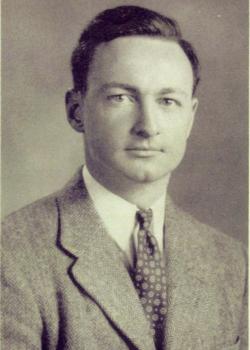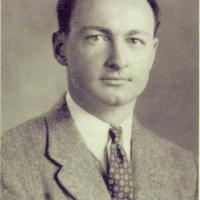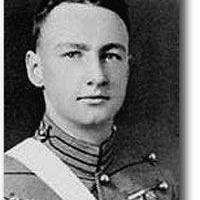WOOD ERIC FISHER JR
WOOD ERIC FISHER JR
Unit & Div
Born
Entered Service From
Died
The following information on Eric Fisher Wood is taken verbatim from the following article: The Courageous Gallantry of Lt. Eric Fisher Wood, Jr., Researched and written by Ronald E. Tschiegg, Graduate of the Valley Forge Military Academy 1952. The information was found on the website of the Chester County Hall of Heroes.
When one considers the many contributions the Valley Forge Military Academy made to the nation’s mobilization during World War II it becomes apparent that the greatest of these contributions to the national effort was the dedicated and valiant service of the alumni in the armed forces. Valley Forge alumni distinguished themselves on the battlefields, in the skies, and on the oceans of the world. There were more than 2,500 Valley Forge graduates in uniform during the war with nearly 40% of them serving as junior officers. Seventy-two died in service to their country and many others were wounded. Many served heroically: six were awarded the Distinguished Service Cross; one the Navy Cross; and one who was awarded the Distinguished Service Cross was also nominated for the Medal of Honor.
The most publicized of these heroic sons of Valley Forge was Lt. Eric Fisher Wood, Jr., ’37, after whom the Academy’s chapter of the National Honor Society is named. Eric Wood was a cadet captain, an outstanding athlete in football and track and the valedictorian of his class. Following graduation from Valley Forge, Eric Wood entered Princeton University, where he continued to excel in scholarship and athletics.
Eric Fisher Wood, Jr. was born to Lt. Colonel Eric Fisher Wood and the Baroness Vera de Ropp in Santa Barbara, California on 25 January 1919. In addition to his military career, Colonel Wood was an architect, an author, an explorer and one of four officers who co-founded the American Legion. Following Eric’s birth the Wood family had two other boys, Alec and Peter and a daughter named Eleanor. The senior Wood maintained his military career and during World War II Brigadier General Eric Wood served on General Eisenhower’s staff and was located in England working with governments in exile and administering aid to thousands of refugees and displaced persons.
In the mid-1920’s the Wood family moved from California to Western Pennsylvania and located in Pittsburgh on a farm called “Journey’s End” near Bedford Pennsylvania. The senior Wood became deeply involved in his architectural business and designed or co-designed many office and academic buildings throughout the Pittsburgh area.
Eric, Jr. was enrolled in first-rate preparatory schools: first, the Shadyside Academy in Fox Chapel and later the Kiski School at Saltsburg, PA prior to enrolling at the prestigious Valley Forge Military Academy located in Wayne, straddling both Chester and Delaware Counties.
Eric was an outstanding scholar-athlete, excelling in the classroom, on the football field as a center and linebacker and in field events on the track team. Wood became the valedictorian of his class with no grade lower than 89. One former cadet described Wood as “the smartest person on the post and that includes the entire staff and faculty.” Another alumnus recalled that he had once been on guard duty with Eric Wood and was amazed to discover, during quiet periods in the guard station, Wood was reading three books simultaneously—rotating from book to book, one chapter at a time.
For all his excellence Eric Wood was no prig and he had a profound disdain for pompous and dubious authority. During his First Class year at Valley Forge, Wood and others hatched a plot to test the mettle of the Commandant of Cadets. They mixed up a brew of oil and gasoline and set the assembly area for fire drills ablaze. When “fire call” was sounded the cadets poured out of barracks facilities and along with the tactical officers were confused about where they should assemble. For this prank Wood was reduced in rank from Captain to Private. However, Wood returned to Valley Forge for a post-graduate year of study while he prepped for entrance to Princeton University and regained his rank as Captain of the Academy’s famed equestrian unit, “D” Troop.
Wood entered Princeton in the fall of 1938. He played football when Princeton was a powerhouse and he threw the javelin on the track team. Wood was dating Margaret Wadsworth of Wayne, PA who was enrolled at the Bryn Mawr College. They eloped and were married on 26 July 1941without the knowledge of their respective parents or their respective educational institutions. At the time, Princeton prohibited their students from marriage but the two families got together with the administration and resolved the matter to the satisfaction of all parties. Within a year, a daughter, Pamela, was born to the Wood family. With his duties as a husband, father and student athlete, Wood managed to graduate with honors from his course in International Studies and was placed 46th in his class of 459.
Wood was also enrolled in ROTC but on the advice of his father he refused an Army commission. Following his graduation in 1942, instead of military service Wood returned to the family farm in Bedford, PA and he and Margaret actually operated the farm for a period of time. In 1943 he joined a reserve unit and because of his previous ROTC training became a 2nd Lieutenant in an artillery unit.
Later in 1943 Wood was called to active duty. He completed the basic artillery officers’ course at Fort Sill and then was assigned to the 589th Field Artilley Battalion, 106th Infantry Division for further training at Fort Jackson, SC.
Margaret Wood was pregnant with their second child as she followed Eric from training camp to training camp from South Carolina, to the Tennessee Maneuver Area and then to Camp Atterbury, Indiana. The 106th Infantry Division completed their training and prepared for embarkation to somewhere in England in the early autumn of 1944.
After a short period of refresher training and re-supply in England the 106th Infantry, prepared for the Channel crossing and the movement across France and Belgium to a quiet sector of the front located in the Ardennes.
The 589th moved on line on 5 December, 1944 and relieved elements of the 2nd Infantry Division. They spent the next week in transition, registering their artillery pieces and strengthening their positions with an overhead shield of logs and branches to protect against air bursts. Eric Wood did not know that his wife gave birth to Eric Fisher Wood, III on 8 December 1944; just eight days before the German counter offensive in the Ardennes which is popularly known as the Battle of the Bulge.
Eric Wood’s heroism during the German counter-offensive in the Ardennes Campaign is legend and exemplified all of the ideals of the Valley Forge motto, “Courage, Honor, Conquer.” Wood’s unit, Battery A, 589th Field Artillery Battalion, 106th Infantry Division, was operating on the northwest slopes of the Schnee Eifel, in the Ardennes near Schonburg, Belgium. The 106th was an untested unit that had been placed in their field positions because the area was thought to be passive. In fact, they were opposite seasoned German units as the initial battle of the Ardennes Offensive unfolded.
Wood’s unit was confronted by an overwhelming German thrust in the initial stages of the Battle of the Bulge. His CO was captured and Wood, the XO, took over as the acting Battery CO. They fought a delaying action, bore sighting their artillery pieces at German tanks and trucks as the Americans slowly withdrew from Schonburg. Wood was the last American officer to leave Schonburg, heading west toward St. Vith, a distance of about 13-km. He brought with him three of the original 12 artillery pieces which would prove to be vital just days later at the battle of Parker’s Crossroads, west of St. Vith.
About to be captured after his 2 ½ ton truck was confronted by a German tank parked squarely in their escape route, Wood, with cat-like reflexes ordered his men to jump out of the truck just before the German tank blasted the truck to pieces. In the confusion of the moment, as some men raised their arms in surrender, Lt. Wood broke and ran away from the astonished Germans. With small arms fire trailing him, he dodged and weaved his way in a zig-zag pattern into a nearby wooded area. Wood survived. He was free . . . and alone.
In the heavily wooded area of the Ommerwald, just north of the main road, Wood met up with another soldier separated from his unit and they encountered a Belgian woodsman who took them in for the night, giving them food, allowing them to dry their clothing and briefing them on the terrain and the German positions throughout the immediate area. After a good night’s sleep they left the village before first light with some food and over the next few days they formed a small band of guerrillas made up of other Americans who were separated from their units. They gathered abandoned weapons, ammunition, food, supplies, and equipment and organized in small groups to harass the German patrols and their supply and communication lines in every conceivable way for the next several weeks.
Belgian citizens from the nearby village of Meyerode testified that they heard small arms and mortar fire from Wood and other Americans operated from their sanctuary in the dense wooded areas near the village, sniping at the enemy as they approached the junction of roads and trails criss-crossing the remote wooded areas southeast of Meyerode and north of the Schonberg-St. Vith road. The group also performed acts of sabotage in the German rear areas. According to the Belgian villagers, Lt. Wood and his guerrillas eliminated approximately 200 enemy troops and supplies over a period of several weeks. Nazi SS General Sepp Dietrich was enraged by the harassing guerilla activity and referred to Wood and his small group of raiders as “criminals and scoundrels.” General Dietrich issued orders to his SS units to find and eliminate them.
Eventually, an enemy patrol approached along a logging trail in the woods near the village of Meyerode, and surrounded Eric Wood. Wood fought back, but was overwhelmed by sheer numbers. He was killed in his desperate attempt to evade capture. When Belgian woodsmen discovered his body on 23 January 1945, there were seven dead German soldiers scattered around him. It was estimated that Wood and the Germans had been dead for about ten days. The Belgians claim that Eric Wood had not been touched by any Germans, because his identity tags and more than 4,000 Belgian francs were found on his body. German soldiers routinely searched the Allied dead, looking for side arms, documents, and money.
The date of Wood’s death is disputed. The official military records and his grave marker at the American Military Cemetery, Henri-Chapelle, Belgium, record the date as 17 December 1945. Belgian witnesses have emphatically maintained that for several weeks Wood, and the group of American guerrillas who joined with him in his personal war against the enemy, disrupted German patrols, communications systems, bivouac and staging areas, supply dumps and columns, causing havoc in the path of the advancing Germans. The uncertainty arises from the Army’s official date of Wood’s death—the date that he was reported missing from his unit. Even though Belgian witnesses testified to his exploits in and around Meyerode for several weeks thereafter, Wood was officially recorded as being deceased on 17 December 1944 by the War Department, according to the Morning Report policies and procedures of the Army.
For his heroic actions on 16 December 1944 and thereafter, Lt. Eric Fisher Wood, Jr. was posthumously awarded the Distinguished Service Cross, the Silver Star, the Bronze Star, and the Purple Heart. He was also awarded the Belgian Croix de Guerre, the Belgian Knight’s Cross, and the Order of Leopold I with gold palm. Wood’s father claimed that Eric Wood was the only American soldier in World War II to receive this prestigious award from the Belgian government. The Belgian citation included these words: “He died weapon in hand. He had lived as an outstanding example of audacity, tenacity and heroism, not only to the American Army but also to the Belgian population of the region.”
In addition to these prestigious awards, Eric Wood was nominated for the Medal of Honor. However, he did not qualify for the award because no American witnesses had survived to attest to his actions following his escape from capture on 17 December 1944. There were, however, other witnesses: the citizens of Meyerode.
Show More
Show Less



